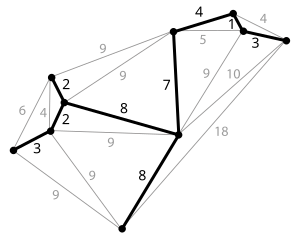Prim's Algorithm in Ruby
One of the first programming assignments of the Algorithms 2 course was to code Prim’s algorithm - a greedy algorithm used to find the minimum spanning tree of a connected weighted undirected graph.
In simpler terms we need to find the path of least cost which connects all of the nodes together and there can’t be any cycles in that path.
Wikipedia has a neat diagram which shows this more clearly:

The pseudocode for the algorithm is as follows:
-
Let X = nodes covered so far, T = edges covered so far, V = all the nodes in the graph
-
Pick an initial arbitrary node s - it doesn’t matter which one it is
-
while X ≠ V:
-
let e = (u,v) be the cheapest edge of the graph where u ∈ X and v ∉ X
i.e. u is a node that has been covered and v a node that has not yet been covered -
Add e to T
-
Add v to X
-
At the end of the algorithm we’ll have a collection of all the nodes in the graph and a collection of the edges we need to follow in order to create a minimal spanning tree. If we sum the weights of those edges we get the cost of the tree.
I used an adjacency matrix to represent the graph i.e. a 2 dimensional array of size n*n (where n = number of nodes in the graph).
If node 0 had an edge to node 3 of weight 4 then we’d put this entry into the matrix:
I tried to get my implementation of the algorithm to look as close to the pseudocode as possible and I ended up with the following:
adjacency_matrix = create_adjacency_matrix
first_edge = select_first_edge(adjacency_matrix)
@nodes_spanned_so_far, @edges = [first_edge[:start], first_edge[:end]], [first_edge]
while !nodes_left_to_cover.empty?
cheapest_edge = find_cheapest_edge(adjacency_matrix, @nodes_spanned_so_far, number_of_nodes)
@edges << cheapest_edge
@nodes_spanned_so_far << cheapest_edge[:start]
endThe code became a bit messy in parts because it relies on a 0 indexed array yet the names of the nodes start at 1. There’s therefore loads of +1s and -1s dotted around the place.
The method to work out the next cheapest node looks like this:
def find_cheapest_edge(adjacency_matrix, nodes_spanned_so_far, number_of_nodes)
available_nodes = (0..number_of_nodes-1).to_a.reject { |node_index| nodes_spanned_so_far.include?(node_index + 1) }
cheapest_edges = available_nodes.inject([]) do |acc, node_index|
get_edges(adjacency_matrix, node_index).select { |_, other_node_index| nodes_spanned_so_far.include?(other_node_index + 1) }.each do |weight, other_node_index|
acc << { :start => node_index + 1, :end => other_node_index + 1, :weight => weight }
end
acc
end
cheapest_edges.sort { |x,y| x[:weight] y[:weight] }.first
end
def get_edges(adjacency_matrix, node_index)
adjacency_matrix[node_index].each_with_index.reject { |edge, index| edge.nil? }
endWe first get all the nodes which haven’t already been spanned and then build up a collection of the edges between nodes we’ve already spanned and ones that we haven’t.
The other bit of interesting code is the creation of the adjacency matrix at the beginning:
def create_adjacency_matrix
adjacency_matrix = [].tap { |m| number_of_nodes.times { m << Array.new(number_of_nodes) } }
file.drop(1).map { |x| x.gsub(/\n/, "").split(" ").map(&:to_i) }.each do |(node1, node2, weight)|
adjacency_matrix[node1 - 1][node2 - 1] = weight
adjacency_matrix[node2 - 1][node1 - 1] = weight
end
adjacency_matrix
endHere we are first parsing the file which involves skipping the first header line and the converting it into a collection of integer arrays representing the two nodes and their corresponding edge weight.
We then put two entries into the adjacency matrix, one entry from node A to node B and one entry from node B to node A. The reason we do this is that this is an undirected graph so we can go either way between the nodes.
To work out the cost of the minimum spanning tree I use this line of code at the end:
puts "edges: #{@edges}, total spanning tree cost #{@edges.inject(0) {|acc, edge| acc + edge[:weight]}}"My full solution is on github so if anyone has any suggestions/improvements they’re always welcome.
About the author
I'm currently working on short form content at ClickHouse. I publish short 5 minute videos showing how to solve data problems on YouTube @LearnDataWithMark. I previously worked on graph analytics at Neo4j, where I also co-authored the O'Reilly Graph Algorithms Book with Amy Hodler.
